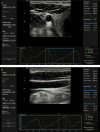Evaluation of common carotid artery in type 1 diabetes mellitus patients through speckle tracking carotid strain ultrasonography
- PMID: 33599210
- PMCID: PMC7963368
- DOI: 10.5152/dir.2021.20025
Evaluation of common carotid artery in type 1 diabetes mellitus patients through speckle tracking carotid strain ultrasonography
Abstract
Purpose: We aimed to evaluate the effectiveness of speckle tracking carotid strain (STCS) technique, which enables measurement of arterial stiffness and strain parameters, in the detection of early atherosclerotic findings in type 1 diabetes mellitus (T1DM).
Methods: We prospectively enrolled 30 T1DM patients and 30 age- and sex-matched control participants with no history of cardiovascular disease. All study population underwent carotid ultrasonography. Radial and circumferential movement of the common carotid artery (CCA) in the transverse plane as the well as the radial movement of the CCA in the longitudinal plane were calculated automatically by using the STCS method. In addition, the strain (%), strain rate (per second), and peak circumferential and radial displacements (mm) were calculated. Arterial stiffness parameters, such as elastic modulus, distensibility, arterial compliance, and β-stiffness index, were calculated using the radial measurements. The mean value of the carotid intima media thickness (CIMT) was calculated semi-automatically for each CCA, in the longitudinal plane. We also analyzed the patients' overall body composition.
Results: T1DM and control groups were compared in terms of strain and stiffness parameters and no statistically significant difference was found (p > 0.05). CIMT was higher in diabetic patients than in the control group (p = 0.039). In both groups, age was correlated with all arterial stiffness and strain parameters (p < 0.05). The duration of diabetes was also correlated with β-stiffness index, distensibility, and elastic modulus in the longitudinal plane (p < 0.05). In the diabetic group, abdominal fat ratio, whole body fat ratio, and fat mass were correlated with radial and circumferential displacement and strain parameters in transverse plane, and radial displacement in longitudinal plane (p < 0.05, for each). Diabetic patients were divided into subgroups according to the presence of nephropathy and dyslipidemia. Although no significant difference was found between the groups in terms of CIMT, patients with nephropathy had higher values for transverse and longitudinal elastic modulus, pulse-wave velocity, and longitudinal β-stiffness index, as well as lower values for longitudinal arterial compliance and distensibility, compared with patients without nephropathy (p < 0.05). Also, patients with dyslipidemia had higher longitudinal β-stiffness and elastic modulus values compared with patients without dyslipidemia (p < 0.05).
Conclusion: STCS ultrasonography is an effective, easy, and noninvasive method for evaluating the arterial elasticity. It may provide an early assessment of atherosclerosis in patients with T1DM, especially in the presence of nephropathy and dyslipidemia; thus, together with CIMT measurement, it may be used more frequently to detect subclinical damage and stratify atherosclerosis.
Conflict of interest statement
The authors declared no conflicts of interest.
Figures





References
MeSH terms
LinkOut - more resources
Full Text Sources
Other Literature Sources
Medical

